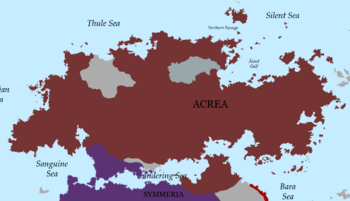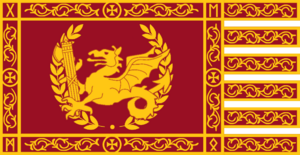Acrean Empire: Difference between revisions
No edit summary |
No edit summary |
||
| Line 20: | Line 20: | ||
|image_map2_alt = | |image_map2_alt = | ||
|image_map2_caption = | |image_map2_caption = | ||
|capital = | |capital = Rena | ||
|capital_exile = | |capital_exile = | ||
|national_motto = | |national_motto = | ||
| Line 47: | Line 47: | ||
The '''Acrean Empire''', also called the '''Empire of Acre''', was ancient empire in [[Eracura]]. Originally a confederation of allied city states and their territories called the Acrean League and grew to become an empire which dominated the continent for nearly a millennium. The Empire served as the home of the [[Nordic peoples]], today one of the largest ethnic groups in the [[Tyran]]. The Acrean Empire reached its peak ca. 500 CE, when its territory spanned from coast to coast across the Eracuran continent and had spread into northern Siduri, though is considered to have been at its relative zenith from 100 BCE to 300 CE. | The '''Acrean Empire''', also called the '''Empire of Acre''', was ancient empire in [[Eracura]]. Originally a confederation of allied city states and their territories called the Acrean League and grew to become an empire which dominated the continent for nearly a millennium. The Empire served as the home of the [[Nordic peoples]], today one of the largest ethnic groups in the [[Tyran]]. The Acrean Empire reached its peak ca. 500 CE, when its territory spanned from coast to coast across the Eracuran continent and had spread into northern Siduri, though is considered to have been at its relative zenith from 100 BCE to 300 CE. | ||
Prior to 200 BCE, the territory of modern day Acrea had long been dominated by a collection of powerful city states, primarily led by five: Rena, Ravenna, Aquileia, Trier, and Coria. Collectively these city-states were known as the Pentarchy, and controlled a majority of trade and extensive territory throughout Acrea. Rena, originally called Acre prior to the city's renaming in 400 BCE, had long been the most powerful of these as it sat along the confluence of the Åare and Kåge rivers as well as easy road access to the Serre river, all of which allowed easy travel and trade to much of modern Acrea and beyond. By the 4th century BCE, the Pentarchy and their allied territories were being increasingly threatened by the expanding [[Sabrian Empire]] which had already dominated much of southwestern Eracura. | |||
Revision as of 14:54, 25 October 2022
Acrean Empire Norðreyjar Norðurkeisarreyjar Caesarregnum Aquilonaris | |
|---|---|
| 200 BCE–1016 CEa 1330 CEb | |
 The Acrean Empire at its greatest extent, ca. 550 CE | |
| Capital | Rena |
| Common languages | Elder Nordic Elder Venetian |
| Religion | Valstígr |
| Demonym(s) | Acrean |
| Government | Absolute Monarchy |
| Keisar (Elder Nordic) Caesar (Elder Venetian) | |
| Historical era | Antiquity to Medieval |
• Established | 200 BCE |
• Dissolved | 1016 CEa 1330 CEb |
| Currency | Mark |
| Today part of | Avallon |
| |
The Acrean Empire, also called the Empire of Acre, was ancient empire in Eracura. Originally a confederation of allied city states and their territories called the Acrean League and grew to become an empire which dominated the continent for nearly a millennium. The Empire served as the home of the Nordic peoples, today one of the largest ethnic groups in the Tyran. The Acrean Empire reached its peak ca. 500 CE, when its territory spanned from coast to coast across the Eracuran continent and had spread into northern Siduri, though is considered to have been at its relative zenith from 100 BCE to 300 CE.
Prior to 200 BCE, the territory of modern day Acrea had long been dominated by a collection of powerful city states, primarily led by five: Rena, Ravenna, Aquileia, Trier, and Coria. Collectively these city-states were known as the Pentarchy, and controlled a majority of trade and extensive territory throughout Acrea. Rena, originally called Acre prior to the city's renaming in 400 BCE, had long been the most powerful of these as it sat along the confluence of the Åare and Kåge rivers as well as easy road access to the Serre river, all of which allowed easy travel and trade to much of modern Acrea and beyond. By the 4th century BCE, the Pentarchy and their allied territories were being increasingly threatened by the expanding Sabrian Empire which had already dominated much of southwestern Eracura.
